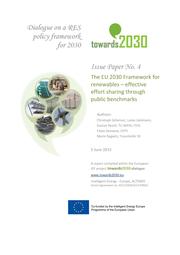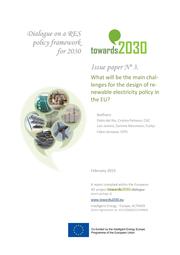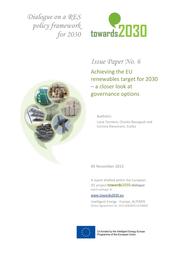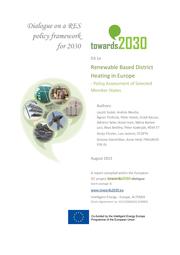Click here to register!
Dialogue on a Renewable Energy Sources (RES) Policy Framework for 2030 - Towards2030
Introduction
The aim of this proposed action is to facilitate and guide the Renewable Energy System (RES) policy dialogue for the period towards 2030. This strategic initiative aims for an intense stakeholder dialogue that establishes a European vision of a joint future RES policy framework.
The dialogue process will be coupled with in-depth and continuous analysis of relevant topics that include RES in all energy sectors but with more detailed analyses for renewable electricity. The work will be based on results from the IEE project beyond2020, where policy pathways with different degrees of harmonisation have been analysed for the post 2020 period. Towards2030-dialogue will directly build on these outcomes: complement, adapt and extend the assessment to the evolving policy process in Europe. The added value of Towards2030-dialogue includes the analysis of alternative policy pathways for 2030, such as the (partial) opening of national support schemes, the clustering of regional support schemes as well as options to coordinate and align national schemes. Additionally, this project offers also an impact assessment of different target setting options for 2030, discussing advanced concepts for related effort sharing.
Publications
The EU 2030 Framework for Renewables - Effective Effort Sharing Through Public Benchmarks
The ‘2030 Climate and Energy Policy Framework’ was adopted by the European Council on 23/24 October 2014. The centre pieces of this framework are a binding target of a 40% reduction of greenhouse gas emissions until 2030 compared to 1990, a 27% share of renewable energies in gross final energy demand and an indicative target of a 27% increase in energy efficiency compared to a ‘business‐as‐usual’ projection of the future energy demand. Contrary to the 2020 policy framework, the EU‐target for renewables will not be broken down into legally binding national targets. Instead, the EU‐target shall be reached by clear, self‐imposed commit‐ ments of each EU member state and guided by a solid governance framework as part of the Energy Union.To this end, the European Commission plans to develop indicators for evaluating national energy plans.
During the towards2030‐dialogue stakeholder workshop on ‘Implementing the EU 2030 climate and energy framework: a closer look at renewables’ held on 18 March 2015 at the premises of CEPS in Brussels, the ques‐ tion was raised how the EU will ensure that the sum of those self‐imposed commitments will be sufficient to reach the overall EU‐target. In the case of a top‐down allocation, individual targets sum up to the overall target of 27%, while the sum of individual pledges may fall short of the overall EU‐target. To close this gap, either a separate financing mechanism would be required or an iteration of pledges, until the gap is closed. As stated in a previous issue paper of the towards2030‐dialogue project,2 public benchmarks of how the EU‐ target could be broken down into individual contributions are a useful starting point for the pledging process. This way, the European Commission would provide guidance to encourage sufficiently ambitious pledges of EU member states and allow them to better assess the contribution needed by each member state for achieving the EU‐target. Such benchmarks could also be part of the set of indicators used by the European Commission to evaluate national energy plans as part of the Energy Union governance mechanism.
The aim of this paper is to present and assess various benchmark setting options. One option is to re‐use the allocation method of the Renewable Energy Directive (2009/28/EC), as discussed in the last issue paper. How‐ ever, it was sometimes critically remarked in the discussions on the adoption of the Directive that by following a flat‐rate and/or GDP‐based approach for defining national efforts, the potential availability of renewable resources and related costs are not taken into account. Therefore, such options are further explored in various combinations in this paper.
What Will be the Main Challenges for the Design of Renewable Electricity Policy in the EU?
Both EU and national policy makers face a difficult task: how to support renewable electricity deployment successfully (i.e. effectively and efficiently) in the short and medium terms and, in particular, in a 2030 horizon. Such main task is directly and negatively affected by certain factors or challenges which have to be dealt with. Some of these challenges which affect renewable electricity deployment might not be strictly circumscribed to the renewable energy realm or even to the functioning of electricity markets. For example, the economic crisis has put a greater pressure on governments around Europe to promote renewable electricity cost-effectively. There are challenges related to electricity markets and others are associated to external developments. Re- newable electricity policies may still be adopted to cope with some of those challenges. However, those challenges are not the focus of this Policy Issue and are addressed in other work packages of the Towards2030 project.
This Policy Issue focuses on the challenges related to policy design (choice of renewable electricity instrument and design element) for future (2030) renewable electricity policy in Europe. Renewable electricity policy chal- lenges are understood as those challenges which comply with two conditions. First, they are directly and indirectly related to factors which affect deployment in a 2030 timeframe in the EU. Since we are interested in those challenges which can be tackled by support policies, a second condition applies: the challenges can be influenced by renewable electricity policy. The challenges identified are of different types, and include technologically-related challenges, macroeconomic challenges, those associated to the current policy discussion, to administrative barriers and social ac- ceptance. More specifically, the following challenges have been initially considered:
- how to adapt support levels to trends in renewable energy technology costs and the uncertain evolu- tion of resource potentials,
- how to appropriately combine R&D support and deployment support for less mature technologies,
- how to cope with lower budgets for renewable electricity support,
- problems in accessing finance (credit restrictions),
- institutional challenges related to the implementation of market-based instruments (MBIs) in general and auctions in particular,
- making auctions and other market-based instruments effective and efficient,
- challenges related to target setting (an EU target without MS targets and an EU target with MS tar- gets),
- merit order effect reducing wholesale prices and revenue for renewable energy technologies ,
- trade-offs between a greater stability and flexibility to adapt to new circumstances,
- delays in administrative procedures,
- trade-offs between NIMBY related to renewable electricity concentration and allocative efficiency,
- social rejection of high or escalating support costs and
- costs falling disproportionately on a given group of the population. This report proposes some policy measures to mitigate the problems associated to those challenges, focusing on instruments and design elements.
Many of these issues are rather complex, however, and, thus, have no simple solution. Therefore, a combination of interventions (in short, policy mixes) will be required. Future re- search and forthcoming reports within the Towards2030 project will further specify the type of policy measures and policy mixes required to meet those challenges effectively and cost-effectively.
Electricity Markets and RES Integration - Key Challenges and Possible Solutions
As the share of intermittent RES (such as wind turbines and solar PV) increases significantly, their deployment challenges the operation of power systems, and impacts the role played by electricity markets that have not been designed to handle the features of intermittent RES.
First of all, intermittent RES feature a variable output that depends on the availability of the resources they are based on (wind does not always blow and sun does not always shine). This variability is worsened by the low-marginal costs of intermittent RES. This means that intermittent RES are willing to generate whenever they can, but only when they can.
Second, this output is also difficult to predict accurately, as the output of intermittent RES depends on complex meteorological phenome- na.
Third, the best generation sites for intermittent RES such as wind turbines are often located far away from consumption centres, creating the need for significant investment in the transmission system. On the opposite, some resources like solar PV are mostly integrated at the distribution level, creating new kinds of flows from low-voltage level to high-voltage level.
Fourth, the development of intermittent RES is still driven by support mechanisms and isolated from most market-signals.
It is therefore clear that electricity market design must be revamped to integrate intermittent RES. On the one hand, electricity markets must cope with the changes in the operation of power systems that are created by the deployment of intermittent RES: new time-definitions must fit RES variability, the day-ahead horizon is not adapted to RES predictability, and existing zones do not reflect the congestion patterns corresponding to the location of intermittent RES. On the other hand, intermittent RES cannot remain at the margin of power sys- tems, and must be more closely integrated into electricity markets.
Report on Identification and qualitative analysis of target setting options
Even though a greenhouse gas (GHG) emissions reduction target for 2030 is not formally agreed upon by Member States yet, this analysis assumes that a future target structure for the EU will be built on at least a binding GHG target. Other target options always encompass a GHG target combined with some more detailed sub‐target(s).
In this section, a selection of target frameworks resulting from combination of the design elements will be described in more detail. The selection has been based on which target framework options have been or are currently relevant in the policy discussion. The focus here is on the target structure itself (blue design elements). In a second step, the selected target structures are assessed according to a number of criteria. Burden sharing options (red design elements) will be discussed in the next section.
The current European energy and climate policy framework centres on the “20-20-20” headline targets to be achieved by 2020 (European Commission 2014a): A reduction of GHG emissions by 20% compared to 1990 levels; a share of 20% RES in gross final energy consumption; and a 20% improvement in energy efficiency. This bundle of targets was agreed upon by the EU Member States in 2007 under the German council presidency (Geden & Fischer 2014). Recent political discussions have revolved mainly around the question of whether this framework ought to be continued or whether further RES and efficiency ‐ gets would be unnecessary for 2030. However, for the sake of a more comprehensive view, other possible target structures are explained here as well. The focus here is on the existence or non‐existence of a RES target. Possibilities for an efficiency target are discussed where they are directly linked to the RES target.
Achieving the EU renewables target for 2030 – a closer look at governance options
When taking office in late 2014, European Commission President Juncker expressed the ambition that the EU should “become the world number one in renewable energies”. To reach this objective, a dedicated policy framework for renewables will be required within EU energy policy, even beyond 2020. In parallel, the European Council agreed the 2030 Climate and Energy Policy Framework for the EU on 23-24 October 2014, which sets new targets for 2030, namely:
- a binding target of 40% greenhouse gas (GHG) emissions reduction compared to 1990 levels;
- a binding target of at least 27% renewables in final energy consumption;
- an indicative target of improving energy efficiency by at least 27% compared to the ‘business-as-usual’ projections of future energy demand.
In March 2015, the European Council anchored the 2030 framework in the Energy Union project, calling for “reviewing and developing legislation related to emissions reduction, energy-efficiency and renewables to underpin the agreed 2030 targets; developing a reliable and transparent governance system”. The European Commission is expected to issue a revised or new Renewable Energy Directive by the end of 2016 or early 2017.
Given the political importance of Renewable Energy Sources (RES), which is also reflected in the public debate on energy, this Issue Paper focuses on the fulfilment of the 2030 renewable energy target, while taking into account the overall framework of EU governance on energy and climate. More precisely, it considers how to reach the binding EU RES target as agreed by the European Council, in the absence of national binding targets. This paper presents an initial overview of the governance options that are currently being discussed and identifies the elements required to ensure the achievement of the 2030 target.
Renewable Based District Heating in Europe - Policy Assessment of selected Member States
According to the NREAPs of the EU member states, renewable based heat generation will play significant role in achieving the 2020 RES targets, and they will continue to play a crucial role in the period up to 2030 as well. Renewable district heating is a major contributor in this process, but further uptake of this technology needs careful design of support and regulatory schemes. In this study an in-depth assessment is conducted out on selected European countries with the aim to identify those policy instruments that could effectively support the development of RES district heating (DH) deployment.
This is a complex task, as RES DH is ‘embedded’ in the national or regional DH systems. This ‘embeddedness’ means that the penetration and development of RES DH systems are very much dependent on the general market structure of the heat market and the regulatory framework of the DH systems, in general. Thus, even similar policy instruments aiming to increase RES based DH generation might have very uneven effects depending on the heat market structure. This problem is further exacerbated by the fact that district heating market structures are typically heterogeneous, not only varying amongst member states but also within a country due to the divergent regional/municipal characteristics of the DH systems.
In addition, the electricity market structures also have impacts on the RES DH development, through the link- ages with the CHP generation. CHP is one of the most efficient ways to produce useful energy, but as its production level is determined in two markets (electricity and heat), and thus, its regulation and promotion as a source of heating entails additional challenges.
Increasing the share of RES-based district heating is a multifaceted task for policymakers, as it can be achieved through various paths with the use of various technologies. In addition, the heat demand characteristics can differ to a great extent (volume and concentration of the heat demand), as well as, the cost structures of the various fuels used in satisfying the heat demand.
The present EU and national energy policies have multiple targets towards district heating. The EU level policy aims to increase DH potential with more efficient CHP production and utilization of industrial waste heat or renewables (article 24 of Directive 2012/27 on energy efficiency, EED), if they are efficient and in a cost/benefit framework they will have a positive balance. The EED directive requires MSs to carry out a cost/benefit assessment (CBA) by the end of 2015 to assess the potential of efficient DH and take the necessary measures to support their deployment. It also requires that during the process of permitting new electricity generation installations, or the ones carrying out major refurbishment, have to go through a CBA assessing the potential to convert it to a cogeneration plant. There is no specific provision in the Energy Efficiency Directive which would directly increase the share of RES in DH systems and the use of this option is driven by the provisions of the national energy policies and legislation.

























